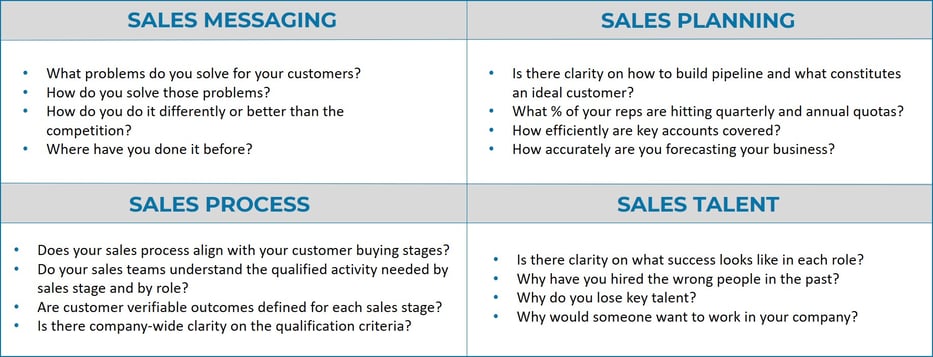
Getting Beyond the “Event” of the SKO
Categories: Sales Kickoff
This blog contains content from our Ultimate Sales Kickoff Resource Guide. Check out all of our sales kickoff resources, best practices and tools here.
Sales kickoffs are a useful tool to enable a sales organization to execute on the organization’s top goals for the year. It is easy to delegate the SKO event or get bogged down in the details of who’s doing what, where they’re doing it and how it’s going to go. After all, it may be an event you do every year. However, the key question that needs to be at the forefront for every sales leader is how are you going to use the SKO to align your sales organization around the critical outcomes you need to achieve in the upcoming year?
As with anything in sales, preparation is the key to success. If you want to ensure long-term positive business outcomes from your SKO, now is the time to start defining what’s next for your sales organization and invest in making it happen.
Think Beyond the "Event"
The first step to ensuring lasting sales impact is to think beyond the “event” itself. The SKO is a moment in time when you have the attention of your team. Use it to generate momentum around a strategic initiative and build the engagement you need from your entire team to maintain that energy after the event.
Right now, we are working with sales leaders to define their biggest opportunities and align a broader change initiative with their planned SKO. As a result, they’re working with their enablement team to strategize around critical pre-SKO and post-SKO activities and deliverables that will support the long-term adoption of new methodologies/processes/behaviors. Here are a few steps they’re taking. You may find value in them as well.
1. Work back from the end goal to define critical execution gaps
You’ve got numbers to hit. You know what’s working well and what isn’t. At the same time, your company may be dealing with marketplace shifts or strategic changes. What do you need to do to make sure your sales organization is set up for success? Consider how you can use the SKO to ensure sales is aligned and equipped to execute. These essential questions around key areas of sales effectiveness may help you decide what focus areas you may want to incorporate into your SKO. Consider how solving those challenges can help you reach next year’s growth goals.

Once you’ve determined your area of opportunity, the next step is to determine the type of sales initiative you need to course correct. This short rapid sales assessment may help.
2. Define the outcomes
Once you determine your gaps, define the outcomes you want participants to gain from the event. Ask yourself this: “What’s most important for sellers to know at this exact moment in time?” What are the key outcomes I want my SKO to achieve?
The answer will help you establish and maintain team agreement on the SKO’s purpose, objectives and measurable outcomes. It will also help you define what success looks like for individual sellers, sales teams, sales leadership and the company overall. Not knowing or giving directives on what you’re trying to achieve from the SKO makes it difficult for your team to execute in a way that drives impact. Dig deeper on what to factor in when you begin to set clear objectives for your next sales kickoff.
3. Stay committed. Stay involved
All too often, leaders don’t focus on the sales kickoff soon enough. They delegate it to enablement teams and start paying attention during the last stages of planning. Remember, procrastination eliminates your options. Lack of early leadership involvement means it’s unfortunately too late to put programs in place that drive the impact they want, so they accept great events with mediocre results.
In our engagements, we have found that when sales leaders dedicate themselves to making the engagement both valuable to their sales teams and aligned to their company’s long-term goals — they’re able to achieve their desired results from the sales initiative. Here are a few examples of how you can stay engaged in the design of your sales initiative and SKO event:
- Stay involved in the development and review of the methodologies, training and content that are tied to your sales transformation.
- Own the responsibility of ensuring the critical concepts of your change initiative are relevant and customized to your sales organization’s execution challenges.
- Leverage your power and influence to make strategic decisions that your enablement team simply can’t make, like ensuring the initiative aligns to the business goals of the company and optimizing how sales operates within other departments.
- Participate in the training. Plan to be present, as much as possible, avoid skipping it or stepping out during the training to take phone calls. Ask questions, participate in group exercises, engage with your managers and people.
Dig deeper on how you can lead in a way that drives seller engagement and results.
4. Use time to your advantage
Start thinking about what needs to happen before your SKO, in order to make it successful. What can you communicate and roll out early on to drive engagement during the event and commitment to consistent execution one month, quarter, year down the line?
Whether through pre-event virtual training, e-learning, or role-specific content, consider what you can roll out now to increase engagement at the main SKO, whether it’s virtual or in-person. Leading up to your SKO, there are likely specific concepts or behaviors you can bring your team up to speed on to maximize time during the actual event and improve seller engagement with your initiative.
Breaking down the change initiative into a multi-phased approach, in a way that works best for the organization (virtually, in-person, hybrid), can help ensure you’re not bombarding your people with too many new concepts at once. Instead, you’re using the time you have to:
- Build awareness around the value of your initiative and a new way of running the business.
- Provide ample time for reps to practice, ask questions and get feedback.
- Drive seller engagement and accountability towards your initiative.
Imagine how much more you could get done during your SKO if you took a similar approach. Time is on your side一if you start now一to make it happen.
5. Consider your manager’s role in achieving broader sales goals
Making managers a meaningful part of your sales initiative ensures that anything presented in your SKO doesn’t fall by the wayside. As you lay the groundwork for a strategic sales transformation that moves the needle, consider how manager accountability and reinforcement play into your ultimate endgame? Do you need to incorporate manager training into the engagement? What high-level roles should they play after the event is over? How will you monitor your managers and determine how well they’re driving the ongoing success of the initiative?
Any changes you launch for next year will be difficult to adopt across the company without managers becoming experts in the concepts themselves. Ingraining new sales concepts and practices into your sales process and the everyday activities of your sellers takes alignment and consistency between your managers and sales reps:
- Alignment; in regards to how they’re applying new concepts to live opportunities.
- Consistency; behind how reps are held accountable for using new concepts. Managers must support reps to ensure they perform high-value sales activities, consistently on every deal.
First-line managers, more often than not, are the linchpin to whether a sales enablement initiative sticks or falls by the wayside. Dig deeper on how to tailor your event in a way that ensures managers are equipped to drive lasting front-line impact.
6. Develop a post-SKO plan
Equally, if not more important than the pre-SKO plan, the post-SKO plan is key to driving adoption and reinforcement of the changes in behaviors, content and processes that you want to stick. With the event strategy outlined and your objectives clear, your SKO should be a jumping-off point to changing sales behavior in a way that will achieve next year’s sales goals.
The actual SKO event, whether virtual or in-person, will likely only last for a couple of days at most. That means you’re left with about 50 other weeks in the year to ensure critical concepts/activities/methodologies become ingrained into the organization and drive consistent results. As you outline your goals for the strategic sales initiative, dig deeper into what’s needed to support the ongoing adoption and reinforcement of critical concepts over the rest of the year.
Don’t Wait.
Next year’s revenue goals may seem like a hefty feat. Your sales team wants to know how you’re going to help them compete, next quarter or next year. Channel the energy around the event towards achieving critical outcomes, versus letting the excitement of getting people together distract from driving adoption of necessary concepts. Act now to lay the foundation for a strategic initiative that sets your sales organization up for success. Start defining what’s next for your sales organization and invest in making it happen.
When sales leaders consider the strategy behind their SKO early, they’re better able to make an impact on its success and ROI. Use our SKO resources to drive the outcomes you need from a strategic, sales transformation initiative.

